Table of contents:
Virtual Fitting Rooms: The State of the Market
Business Value of Virtual Fitting Rooms for Brands and Retailers
How Virtual Fitting Technology Works
Challenges of Implementing AR Fitting Rooms
Online shopping is big. People certainly like the convenience of ordering stuff online and getting it delivered to their doorstep in a couple of days — there’s no commute to the store, no lines at the fitting room, no worrying about the product being in stock. This approach is very convenient for virtual grocery shopping. Dressing up is all about technologies these days.
But with clothes, the shopping experience is a bit different. We all know how much seeing the physical article matters. It’s important to try the shirt on to make sure it fits, or check whether the sneaker color goes with your pants.
This is an even bigger problem during a time of remote work and limits on travel. How do you bring the offline fitting-room experience to the online store?
Let’s see how custom virtual reality software development can significantly improve the user experience of modern stores.
Virtual Fitting Rooms: The State of the Market
Business Value of Virtual Fitting Rooms for Brands and Retailers
How Virtual Fitting Technology Works
Challenges of Implementing AR Fitting Rooms
In 2020, the size of the virtual fitting room market was valued at USD 2.73 billion. The experts at Grand View research claim the market will continue to grow at a compound annual growth rate of 25,2% from 2021 up to 2028.
This market growth is driven by the expanding popularity of e-commerce, fashion vendors’ concerns about providing customers with quality products, and the need to respond to growing demand for a customizable shopping experience.
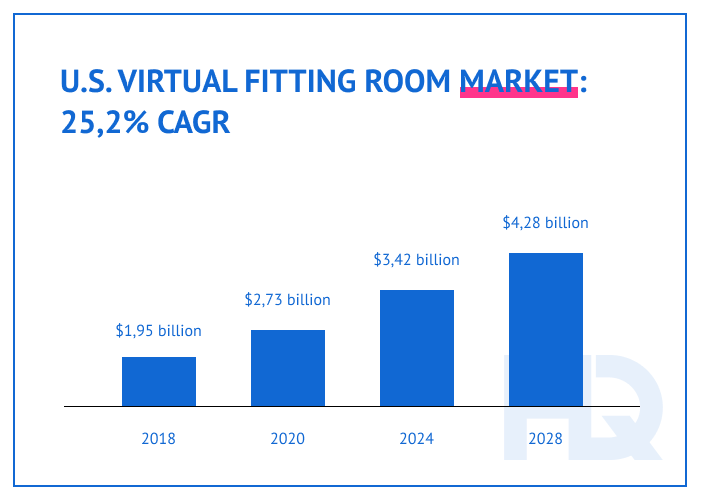
With advanced technology such as high-quality smartphone cameras and smart mirrors continuing to penetrate our lives, we can expect a growing adoption of VR technology.
As the experts have discovered, the experience of a virtual fitting room reduces the likelihood that customers return the product due to sizing issues.
It’s no wonder that many companies are seizing the opportunity to implement Virtual Reality into their online and offline shops.
Back in 2017, Gap announced its VR fitting room app at the Consumer Electronics Show. Developed by Google, the DressingRoom app allows shoppers to try out clothes using a virtual avatar. They can choose an avatar from five different body shapes and see how different clothing items fit on it.
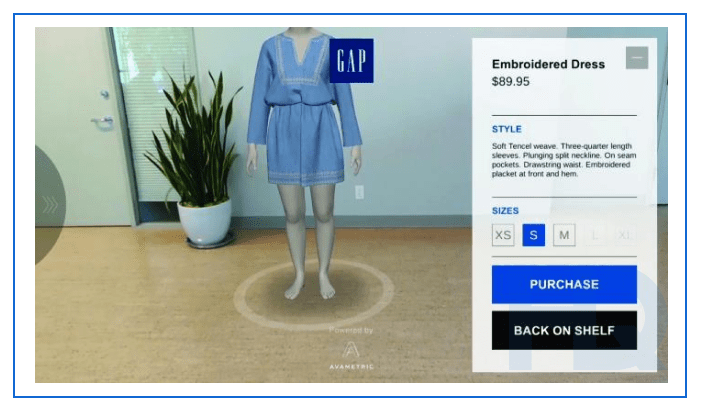
Adidas has been using virtual dressing rooms for a long time. Their solution is called BodyKinectizer, and it is based on Microsoft Kinect. The shop assistant scans the customer’s body, allowing the virtual avatar to replicate their size and shape. Then, the customer can try various clothing items on virtually to see how they would fit.
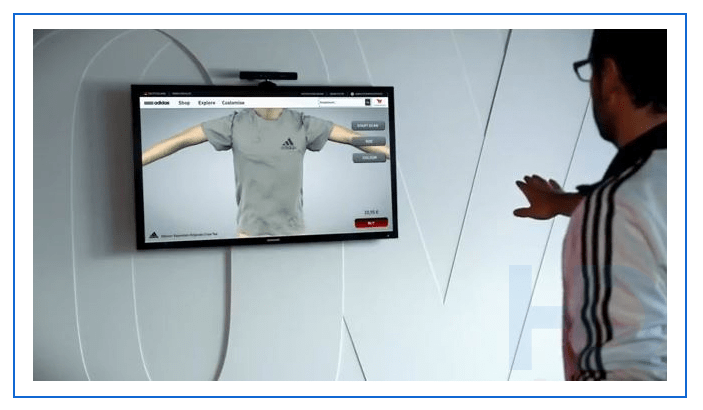
So, what perks do companies get from virtual fitting room technology?
Though policies restricting offline shopping during the global pandemic have spurred the adoption of AR and VR, particularly the increased demand for virtual fitting rooms solutions, the technology isn’t simply targeted at replacing brick-and-mortar experiences with virtual stores.
Here are some other benefits retailers derive from virtual fitting room apps.
We’re used to tech manufacturers like Samsung, Apple, Huawei, and others putting their products on display and allowing customers to hold them in their hands.
Want to build an AR app for retail? We’re ready to help!HQSoftware has a team of skilled professionals ready to tackle the project. Let’s talk!
Anna Halias
Business Development Manager,
HQSoftware
The main reason for that practice is that holding a new device gives customers a sense of ownership that makes them more likely to purchase it.
That is true for clothing as well — when you get to try the item on and see how you look wearing it, you may just be tempted to buy it.
And that is exactly what virtual reality in online shopping brings: customers get to try on clothing from the comfort of home and be reasonably sure the item they’re buying will fit perfectly.
For the retailer, this means an increase in sales. According to the Retail Perceptions Report, 40% of customers are likely to pay more for a product if they have the chance to experience it in AR.
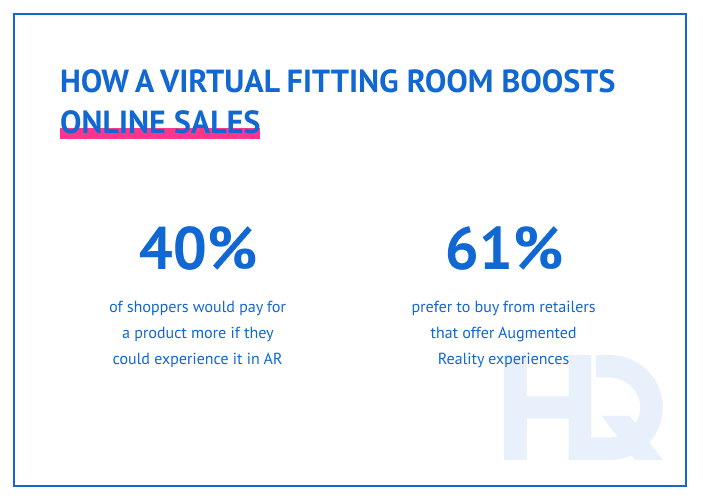
Despite all the benefits of online shopping, some factors make it almost impossible to be sure you’re buying the right product.
Some shoppers, frustrated by the difficulty of determining the exact color and fabric quality of a garment from photographs on screen, may even abandon online stores.
And everybody knows that standardized clothing sizes are a joke; hardly anyone finds items purchased online fit them perfectly every time.
How do modern businesses use AR to increase their revenues and outperform their industry competitors?

Offline stores have their own downsides, including crowded spaces, limited selection, and checkout queues.
Thus, to enhance the customer journey, virtual shopping comes in. It spares customers from having to go to numerous stores looking for what they want, waiting in line or even changing clothes, since they can try out a large number of outfits using a virtual avatar.
Customers can see how the outfit fits the avatar before purchasing it, with customizable avatars helping them make even more precise choices.
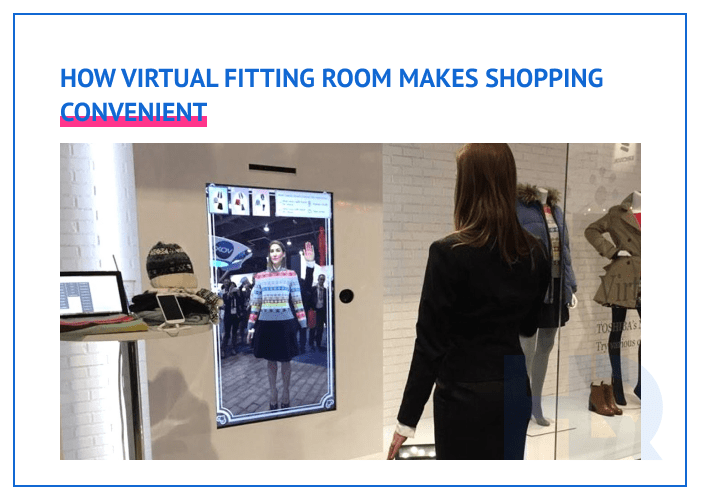
Potentially, customers could see how the outfit looks in different lighting conditions and environments, to make sure they’re getting the color they want.
The greatest challenge for retailers right now is not only attracting new customers but encouraging them to return.
Boosting customer retention helps retailers improve their return on investment; serving returning customers costs 5 to 25 times less than acquiring new customers.
That means retailers must offer unique and personalized shopping experiences that customers will want to come back for.
A virtual dressing room is a unique experience bound to interest many people. Customers will have tons of fun playing around with virtual avatars and trying on various outfits.
Retailers can offer fitting rooms right through their mobile apps, which means the customer can utilize the technology from home. The convenience of that might also secure them as regular customers.
High return rates are an acknowledged problem for online stores: around 30% of all products purchased online end up being returned. Compared to offline stores, where the rates come in at 9%, that’s a huge difference.
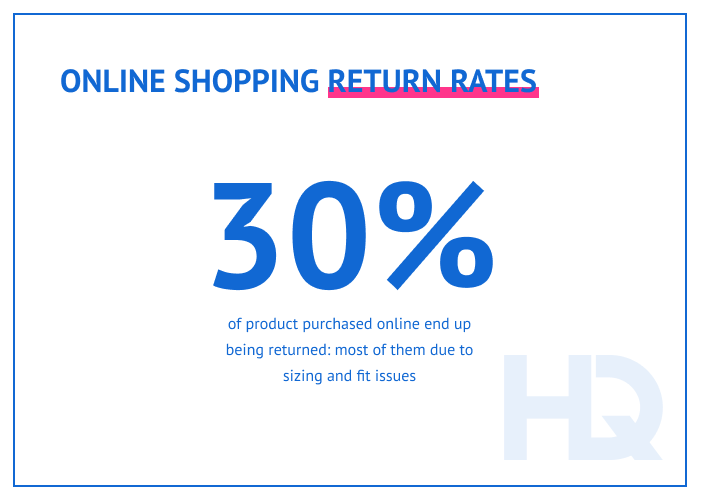
The majority of clothing returns happen because of fitting and size issues. As we have stated before, you can’t really trust sizes listed on product pages.
Virtual clothes-fitting apps can help. Using the store application, the user would be able to create or choose an avatar with their own body composition and try on the clothing they need virtually.
This would make it easier to find clothes that will fit the customer perfectly, thereby increasing the likelihood they will be satisfied with their purchase and won’t return it.
Now that we have an idea of the benefits of applying Virtual Reality in retail, let’s look into how such apps actually operate.
Though the process appears simple to the customer, some advanced tech goes into scanning the customer’s body and generating 3D models.
The process is mostly the same when a customer is shopping offline or through the mobile application, with a few differences. Let’s break it down into steps.
The first step is to choose the outfit. In a brick-and-mortar store, the customer chooses clothing to try on, picks it up from a shelf or rack and goes over to a smart mirror that acts as a virtual dressing room.
The mirror scans the items they have chosen using radio frequency identification technology, or RFID. It aggregates detailed information on a particular item, which helps to create a 3D model of the garment using Artificial Intelligence or Augmented Reality.

If the customer is using an online store, there’s no need to scan anything: the shopper just chooses the item and taps a button to try it on. The 3D models of clothing are already generated.
Then, there’s the avatar. With some products, such as glasses or shoes, you can do without the avatar. In this case, the software can use a smartphone camera or a smart mirror to see the customer and overlay a 3D model of a product on the customer’s image. Apps such as those for Lamoda and Nike are already doing this with their shoe selection.
But when it comes to shirts and so on, you need an avatar. Here, the software relies on AI and AR to scan the customer’s body and apply their composition features to their avatars. Some more primitive solutions only offer a predetermined set of avatars.

Now that the avatar and clothing models are prepared, the customer can put them together.
VR technology overlays the scanned items over the customer’s avatar, so the buyer can see how a particular outfit would look on him or her.
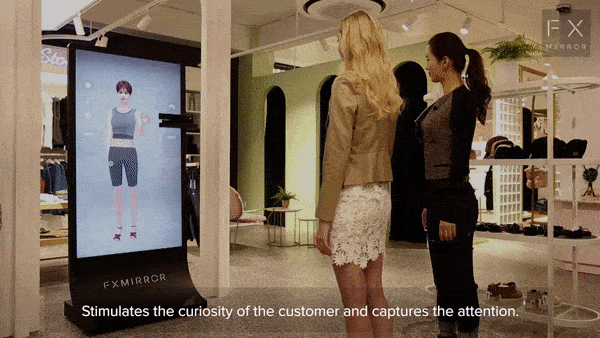
There’s no need to physically change clothes, which makes trying things on a much faster process and also makes online shopping more convenient.
But there are some factors that can make applying virtual fitting room technology more difficult.
As with any complex technology, virtual dressing rooms include a plethora of advanced tools, incorrect application of which can actually lead to zero sales increases and even financial loss.
Let’s see what challenges the retailer faces when building virtual clothes fitting apps.
Building even a very simple application costs money. But virtual dressing room solutions can be expensive because of the added costs of:
Those expenses can pile up rather quickly.
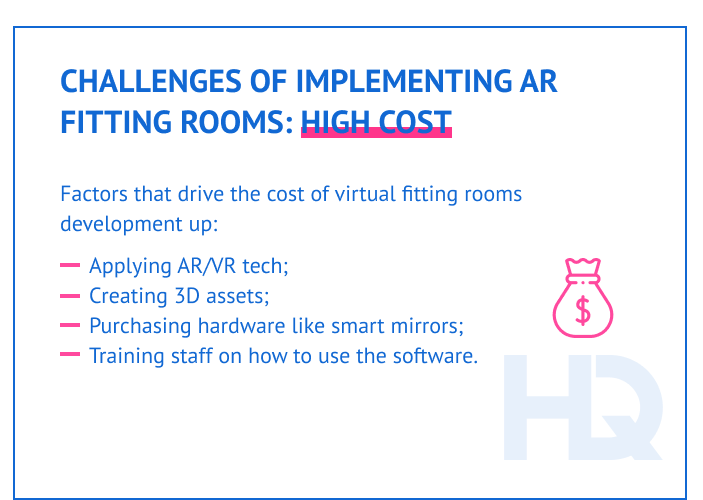
Done right, however, virtual fitting rooms will result in increased sales, improved customer retention, and decreased return rates.
AR fitting room development is a field that requires deep expertise in working with Augmented and Virtual Reality, the Internet of Things, and Artificial Intelligence.
Without the relevant experience, the retailer might fail to find the proper use case or choose the right development tools, and spend too much.
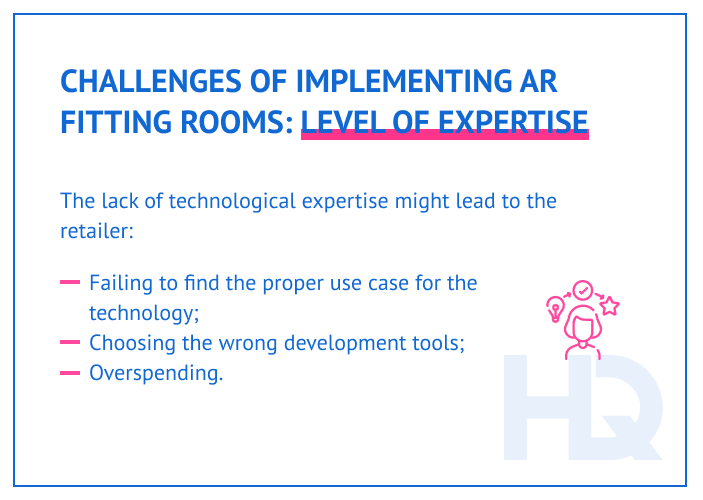
Partnering up with an experienced virtual fitting room developer will help retailers avoid costly mistakes.
As we have established, virtual fitting room solutions can substitute for the experience of trying clothes on in offline stores and bring the same experience to online ones.
But there are obvious limitations.
First of all, AR technology can’t let a customer touch the item. For many shoppers, it is as important to feel the fabric and see the quality of the workmanship as it is to ensure the right fit.
Besides not being able to experience the clothing item physically, shoppers may feel some doubt that the item they’re ordering is exactly like the one in the pictures. Almost everyone who shops online has encountered a situation where the delivered item wasn’t exactly what they ordered.
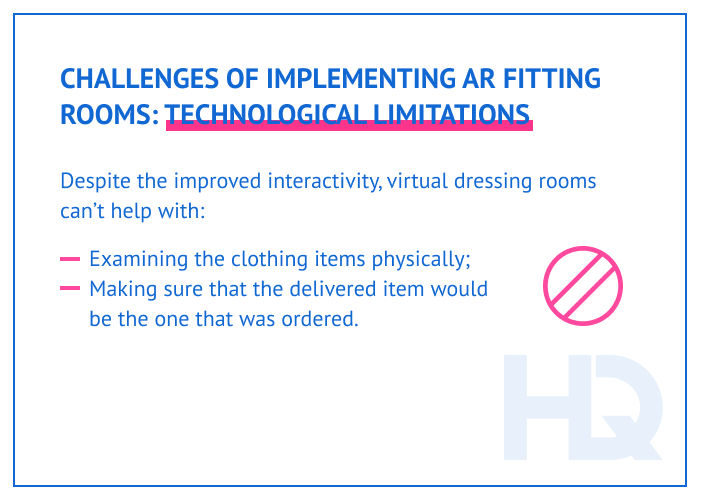
But we’ll surely see those challenges addressed as the technology moves forward. As of now, every step towards improving customers’ shopping experience does seem to generate ROI high enough to consider AR fitting room development.
The question is: what does it take to create one?
There are many factors to consider when estimating the cost of virtual fitting room development.
Let’s break down those factors.
First off, the retailer must establish what kind of VR fitting room is needed.
We can divide dressing room software into the following types, based on the way they approach the fitting process:
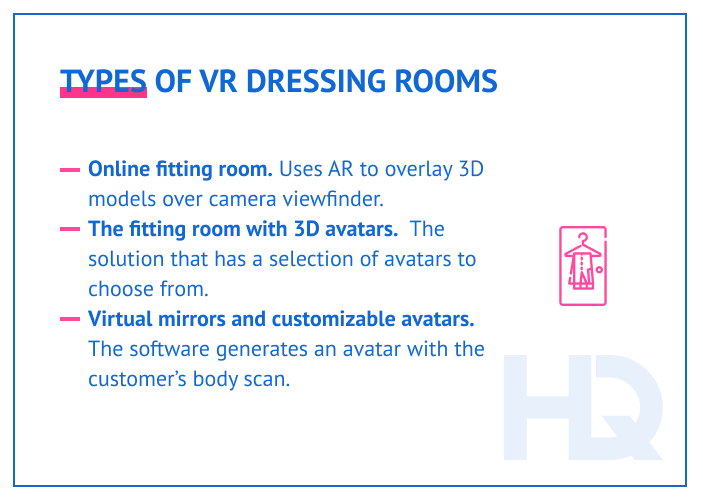
In terms of cost, there’s a direct correlation between the complexity of the software and the development cost.
Having decided on the type of virtual fitting room desired, the retailer can start thinking about actually building it. Let’s see how the development process influences the cost.
First and foremost, the cost of development is influenced by the selection of specialists working on the project.
There are two connected factors: software developer rates and project duration.
Complex software projects take a lot of time to complete, resulting in more hours of development. More hours spent on the project result in higher expenses; how much more depends on the developers’ rates.
Let’s dive into the details here, starting off with figuring out who actually works on the project. The usual software development team consists of:
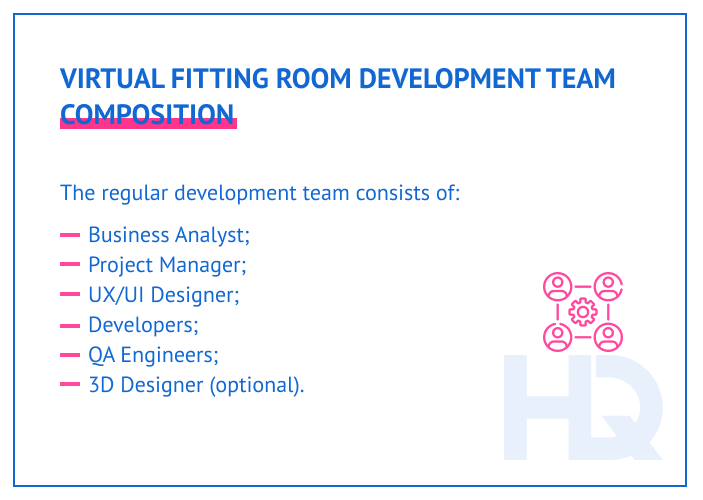
Depending on a particular case, the retailer might need the whole package, or do without certain professionals—for instance, a BA if the company appoints its own.
Another way of controlling development costs is hiring software engineers from areas with lower salaries. For example, developers from Estonia charge lower rates while maintaining a high expertise level.
Also, the retailer must keep in mind the cost of creating content for a virtual dressing room. That includes 3D models of products that the retailer has for sale and would like to make available for virtual try-on.
For that, the retailer will need to hire a 3D designer.
The last thing that directly correlates to the cost of software development is the number of features the software must have.
Building and implementing each feature takes time, so the retailer might have to narrow down the features to those that are most essential — nobody wants to pay for stuff that is barely used.
Let’s take the virtual fitting room as a part of an online store, for example. Here are the features that go into the software and how much development time they require:
| Feature | Development time |
| Importing product pictures | 40 h |
| User account management and authorization | 286 h |
| UI components | 108 h |
| Room/shopper pictures | 80 h |
| Comments | 80 h |
| Download image | 8 h |
| Forgot password | 31 h |
The total time comes up to 833 hours, resulting in around $30,000 for the project. Keep in mind that the cost is based on the average developer rate of $35/hour in Estonia.
The HQSoftware team has already gained profound expertise in implementing Virtual Reality in retail. We have completed numerous projects for the e-commerce industry, helping companies grow their business and streamline their operations.
With regard to virtual fitting rooms, we have partnered with a software development company that creates software for fashion providers to build a mobile app that allows customers to create their avatars and try on clothing items.
The mobile app enables customers to take photos of themselves from various angles, which are used to generate a realistic avatar that has all of the body composition features of a customer.
This way, shoppers are able to try on the clothes they would like to purchase, gaining a clear idea of how the items would fit them.
In addition to the mobile application, HQSoftware developers have also built a web service that runs on a smart mirror. This is meant to be used in offline stores and provides a similar experience as the mobile fitting room, with the customer interacting through a tablet connected to the mirror.
If you have a similar project in mind, contact us. We will talk about your ideas, help you evaluate them, create a project specification, and deliver the project.
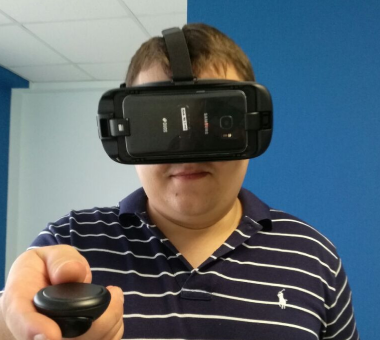
AR/VR Expert
A developer with extensive expertise in AR/VR, very ingrained into the topic of Mixed Reality development. Shares his knowledge and the results of many years of work.
We are open to seeing your business needs and determining the best solution. Complete this form, and receive a free personalized proposal from your dedicated manager.

Sergei Vardomatski
Founder